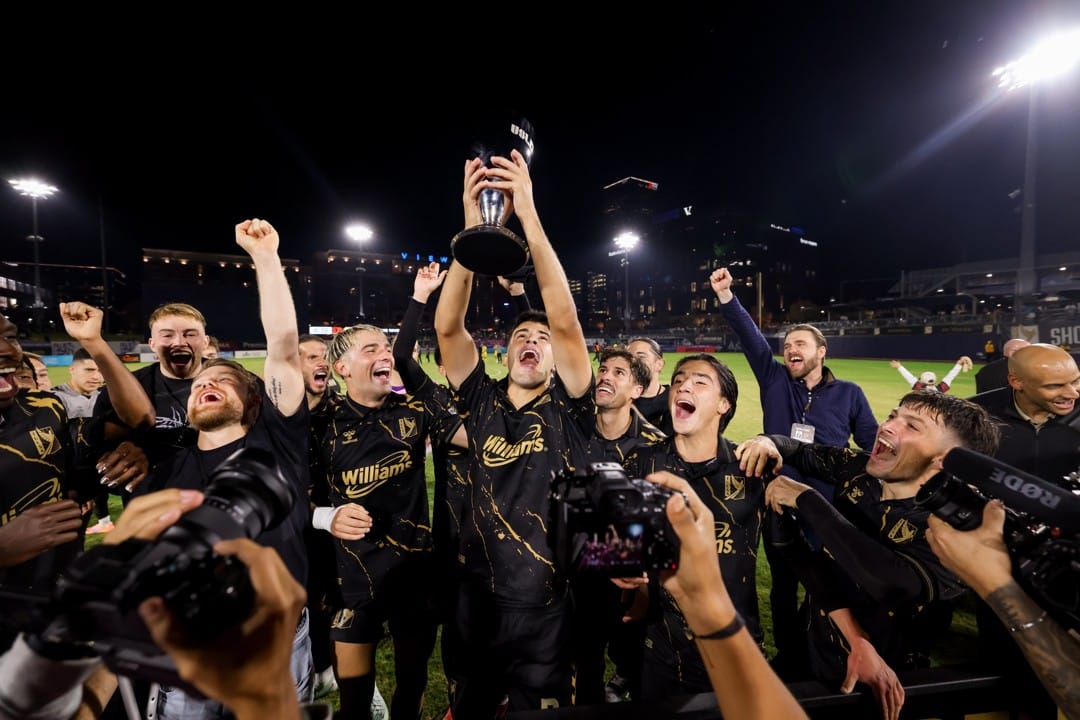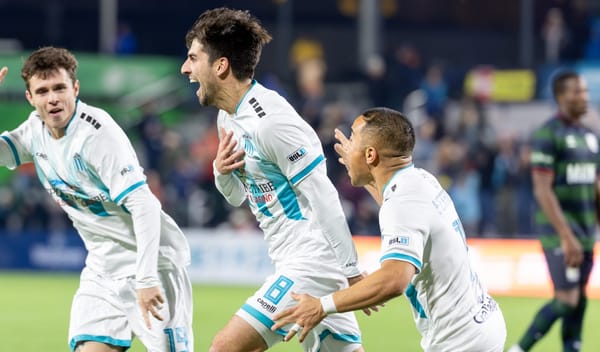Tape Session: Tulsa, Pittsburgh, and the title
What the video tells us about the USL Championship title

Especially prepared readers might be questioning the premise of the piece. I've been looking at existing game tape throughout the 2025 USL playoffs...but, uh, Tulsa and Pittsburgh didn't play this year.
Nevertheless, we forge on. Here, I'm going to lay out a few examples using Tulsa- and Pittsburgh-esque opponents to recreate the same sort of analysis. Let's dig in.
In terms of their pressing and passing profiles, the Indy Eleven were the closest tactical match to FC Tulsa this year. Indy's average pass traveled 10.8 yards upfield against 11.2 for the Western Conference champs; the Eleven's PPDA came in at 7.3 versus 6.2 on the Tulsa side. Poor man's Tulsa to be sure, but stylistically similar nonetheless.
On the other end, Pittsburgh and Louisville are the best coupling. That pair ranked in the USL’s top three for average defensive action height, coming in with marks more than 45 yards upfield. The clubs also ranked in the Championship's top-four in terms of goal kick launches (above 80%), and were known for expansive use of their outside backs.
When Tulsa met that Pittsburgh-style opponent back in July, they used a 3-4-3 shape much like the one we saw in their Western Conference Semifinal win against Phoenix Rising. As always when facing a back-three side, Luke Spencer’s side looked to play quite direct, unsettle their hosts, and use rapid side-to-side movement in the final third to succeed against a low-block 5-4-1.
That’s what’s seen here. Tulsa starts this sequence with a short throw-in from the left sideline – one that, frankly, you’d expect to be taken long via Travian Sousa in the title game. Still, what ensues after the throw is useful to examine.
Tulsa adopts a very narrow attacking shape, almost 3-1-5-1 in nature thanks to a high-pushing No. 8 in the right halfspace (i.e., the kind of spot Jamie Webber would occupy in this shape). On one hand, that look forces the opposing defense to get narrow. Moreover, the presence of the elevates center mid freezes Louisville’s widest defender on the far side.
As Tulsa restarts, they patiently work the ball through the overloaded left flank, waiting to switch the point. When they do, overlapping wingback Lucas Stauffer is ready to receive, play in the high No. 8, and thus tee up into-the-box service for striker Taylor Calheira. It’s intelligent soccer, featuring spatial understanding that would challenge any low block.
Back in this July matchup, Tulsa also used dead balls to their advantage. Their only goal at Lynn Family Stadium came off a 95th minute corner kick; a third minute long throw from deep within the defensive own half turned into a dangerous break, with Calheira receiving over the top of a near-side center back and cutting the ball back to winger Alex Dalou for a shot against a rotating defense.
On the other side, how can Pittsburgh break Tulsa down? You're starting off in a better position than New Mexico in the Western Conference Final from the jump, at the very least. United's commitment to short passing played into the opposing press, and their lack of big bodies and second-ball muscularity only worsened the problem. The Riverhounds are built different: they ranked second in the USL in aerial wins per game (22.7, one more than FC Tulsa) and comfortably led the division in recoveries (48.4).
Supposing Pittsburgh can get into the attacking third in that forceful manner, on-ball tempo and off-ball movement will define their ability to break down Tulsa's 5-4-1 (or 4-4-2?) block.
Here, it's incredibly bold center back positioning that does the job, providing a loose proof-of-concept. Louisville allows their right-sided defender (marked in black) to push up like a legitimate center mid, thereby drawing the attention of half the Tulsa midfield.
Because of that alignment through the middle, there's room behind the 5-4-1's central line for a third-man run by a No. 10 to break through. It’s the sort of move Robbie Mertz excels at making, in fact. Mertz led all USL players with 22.9 final-third passes per match this year because of that terrific sense for receiving in tight spaces.
Back in the example, a sequence of clever passes allows that Mertz stand-in to receive and take a dangerous shot on the mouth of goal. You might argue that this is more of an all-out approach than Pittsburgh will offer, but consider the shape here. At the very beginning of the play, both members of Louisville's pivot are low; numerically, it's a 4-5-1 of sorts. Replace the underlapping verve of defender Sean Totsch with that of Pittsburgh midfielder Danny Griffin, and you're suddenly in 3-1-5-1 territory that's functionally quite similar to the Rob Vincent formula.
Tulsa has tightened up since this point in the summer. Discipline in the defensive third was their strength, hence why they allowed just 0.057 xG per box touch. In other words, opponents needed to take roughly 20 touches in Tulsa’s 18-yard box to produce a full expected goal, the third-lowest mark in the Championship.
Nevertheless, Louisville did well to test that structure with quick restarts over the summer; think in the mold of a goalkeeper like Eric Dick restarting play with an ambitious throw immediately after claiming a cross. If you can catch Tulsa before they’re settled, you’ve got a puncher’s chance at avoiding their brick-wall block.
As always for Tulsa, aggression will be key. If they can use the high press as a tool to keep play in their attacking zone and limit Pittsburgh's breakout potential, they'll be in business. The high press is dually beneficial in that it can (1) produce short-field attacking opportunities and (2) disrupt opposing patterns. USL leaders with 4.3 final-third recoveries per match, no one does those things better than FC Tulsa.
Here, you see how the Tulsa-esque Eleven accomplished that end. To start, Pittsburgh builds on the edge of their own half in the wake of a post-long ball recovery. Unlike in the conference final, they're under instant pressure by the opposing 3-4-3. Every touch is pressed, and Griffin has to drop ultra-low to lend a helping hand.
By the time the camera cuts to a wider angle, you can see the dilemma: three forwards and a hard-charging center mid are stopping vertical progression and forcing Pittsburgh backwards. There's an enormous gap between the Riverhounds‘ "three plus one" possession base and the front end, meaning that any second-ball recovery will be a pyrrhic victory; there’s no easy way to settle in the final third, and Tulsa still has six field players back in shape.
The Riverhounds do regain, but they’re instantly on the back foot. Again, they're pressured, resulting in a deflected pass that caroms out of touch. Expect plenty of similar sequences in Oklahoma. Indy was extremely aggressive using their center backs as upfield markers back in early October, and that's a regularity within the Luke Spencer system. Likewise, the refusal to stay passive even at halfway will surely define the title match.
Pittsburgh will need to maximize transitional moments, just like they did throughout the first 30ish minutes against Rhode Island. While that spell didn’t actually result in any fastbreak chances by Opta’s reckoning, it set the tone for a wire-to-wire performance where the Riverhounds completely controlled the tempo.
Here, you see them spark a dangerous transition move immediately after an opposing turnover. When Indy gives the ball away to Beto Ydrach, he keeps his head up and sees a wave of Eleven midfielders crashing upfield against Pittsburgh’s double pivot. Rather than succumb to the pressure, Ydrach spies an opening; Griffin and wingback Junior Etou have a two-on-one if a line-skipping ball can connect.
Ydrach’s pass here is absolutely lovely, and it ultimately allows Etou to isolate against a central defender in the final third. He’ll beat that man, cross in, and nearly set up a goal for Augi Williams.
Given all those examples, what can we take away? Saying “trust the process” is passé, but it’s not far off. Tulsa needs to trust their verticality, keep up their intensity in the middle third, and maximize their side-to-side threat close to goal. Pittsburgh is built to be competitive in physical battles, but they must pair that identity with the bright, composed 3-1-5-1 attacking we’ve seen throughout the playoffs.
Whichever team does those things to a better degree can expect to hoist a trophy around midday on Saturday.
Cover Photo: FC Tulsa / Twitter




